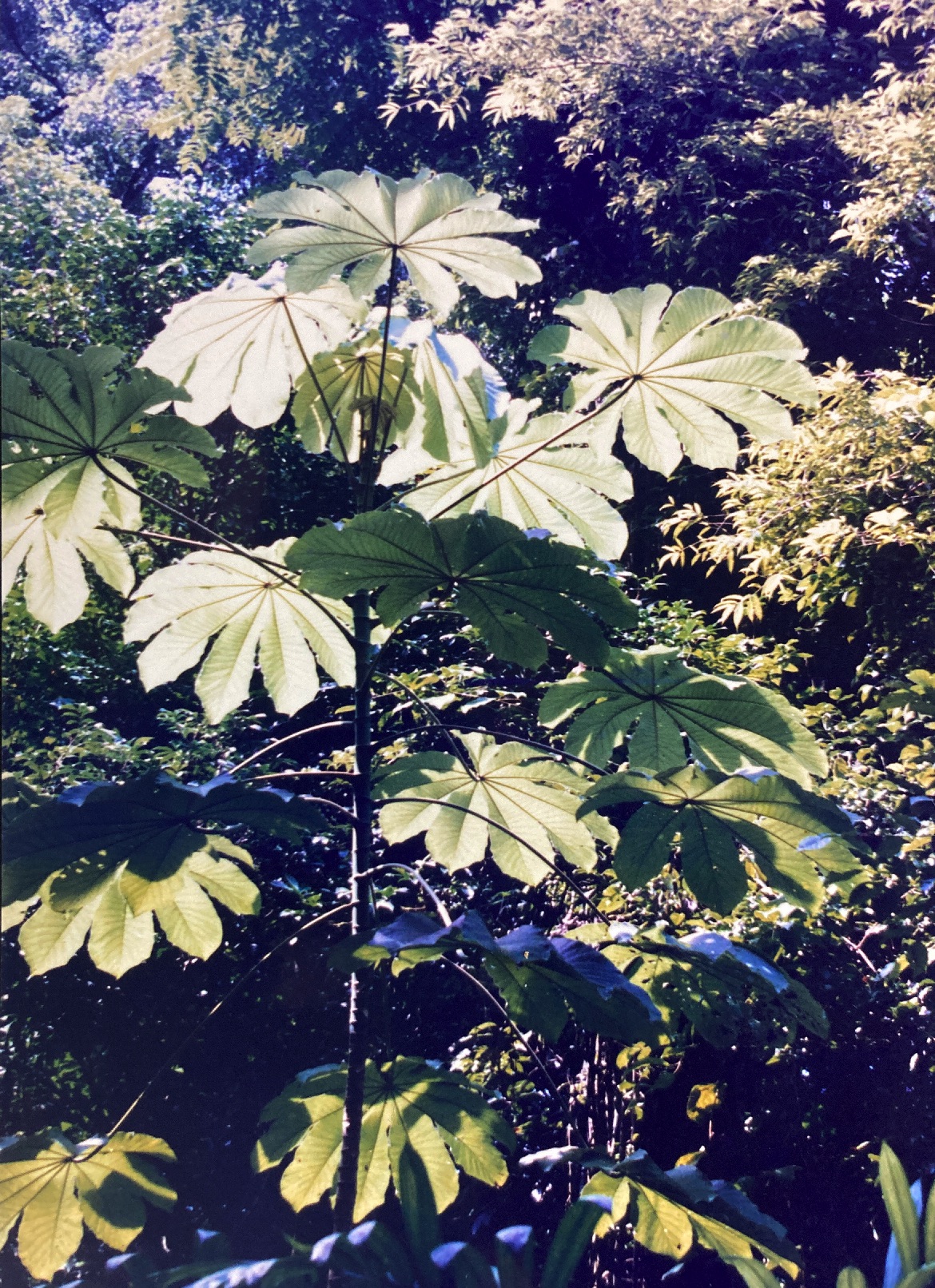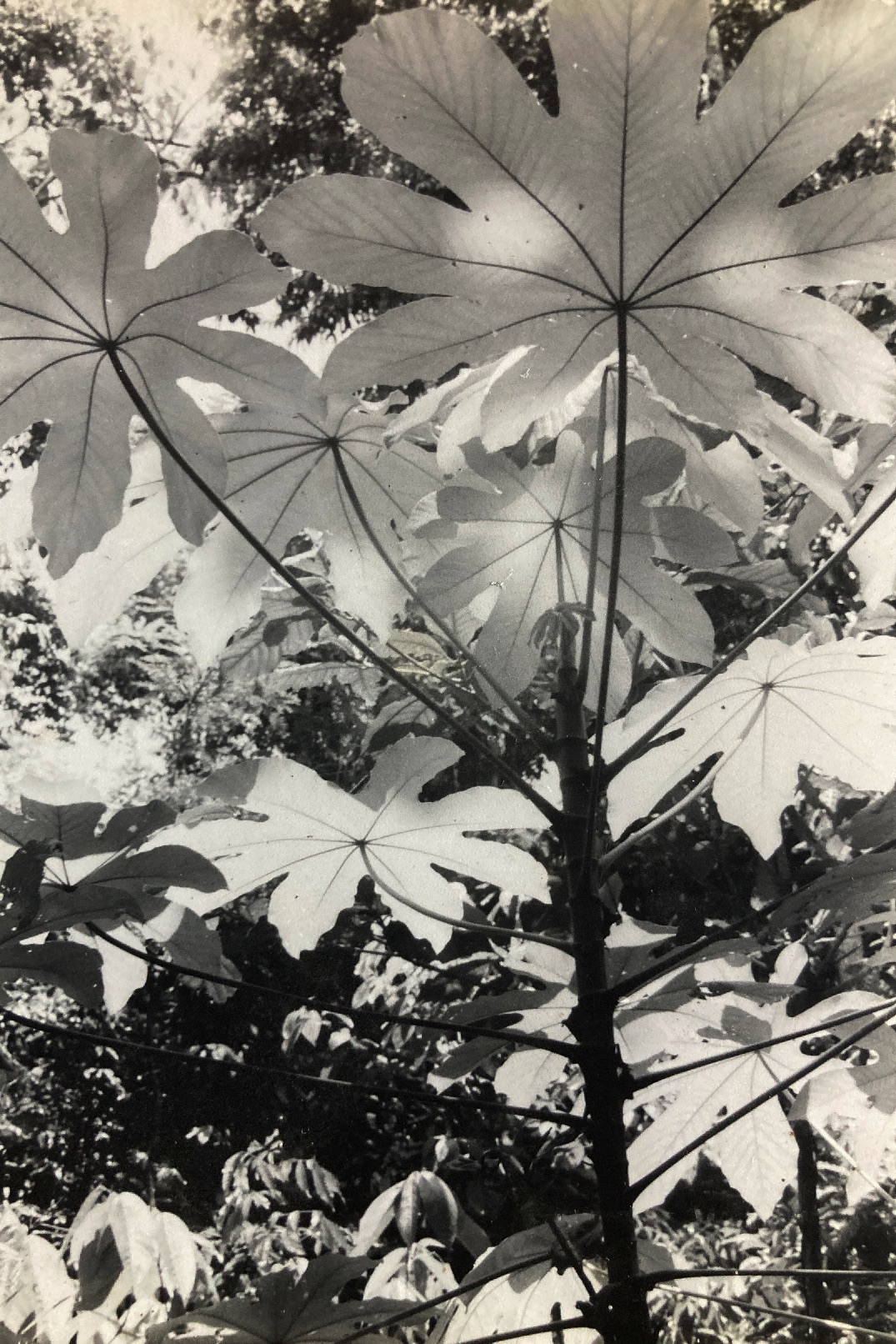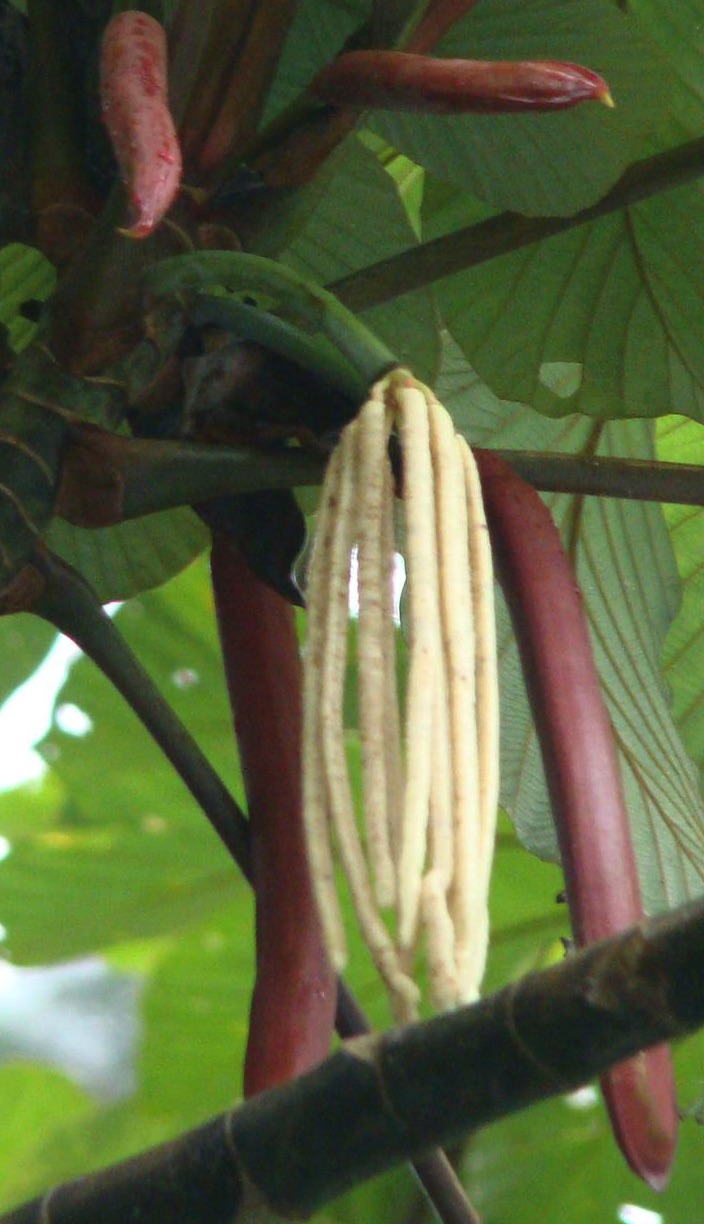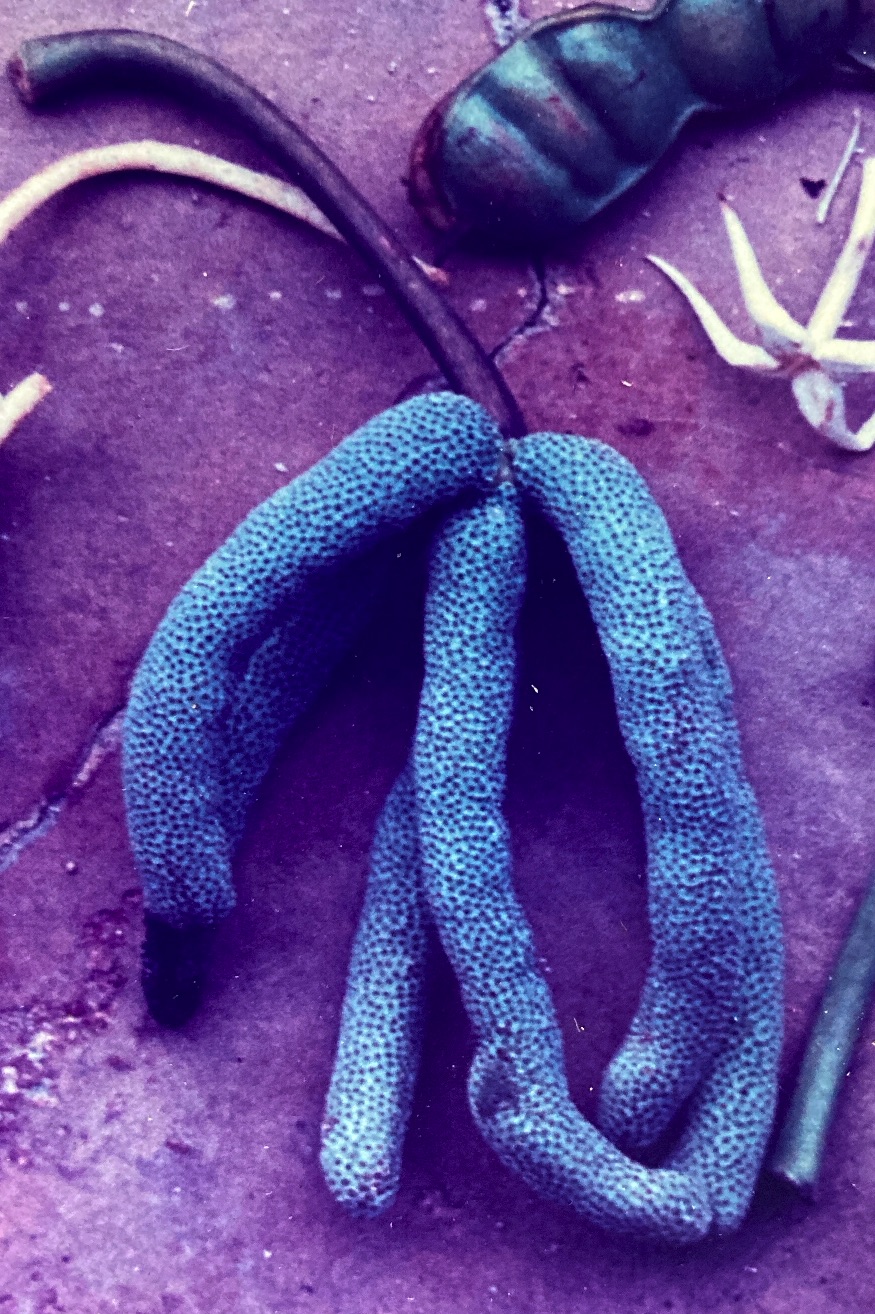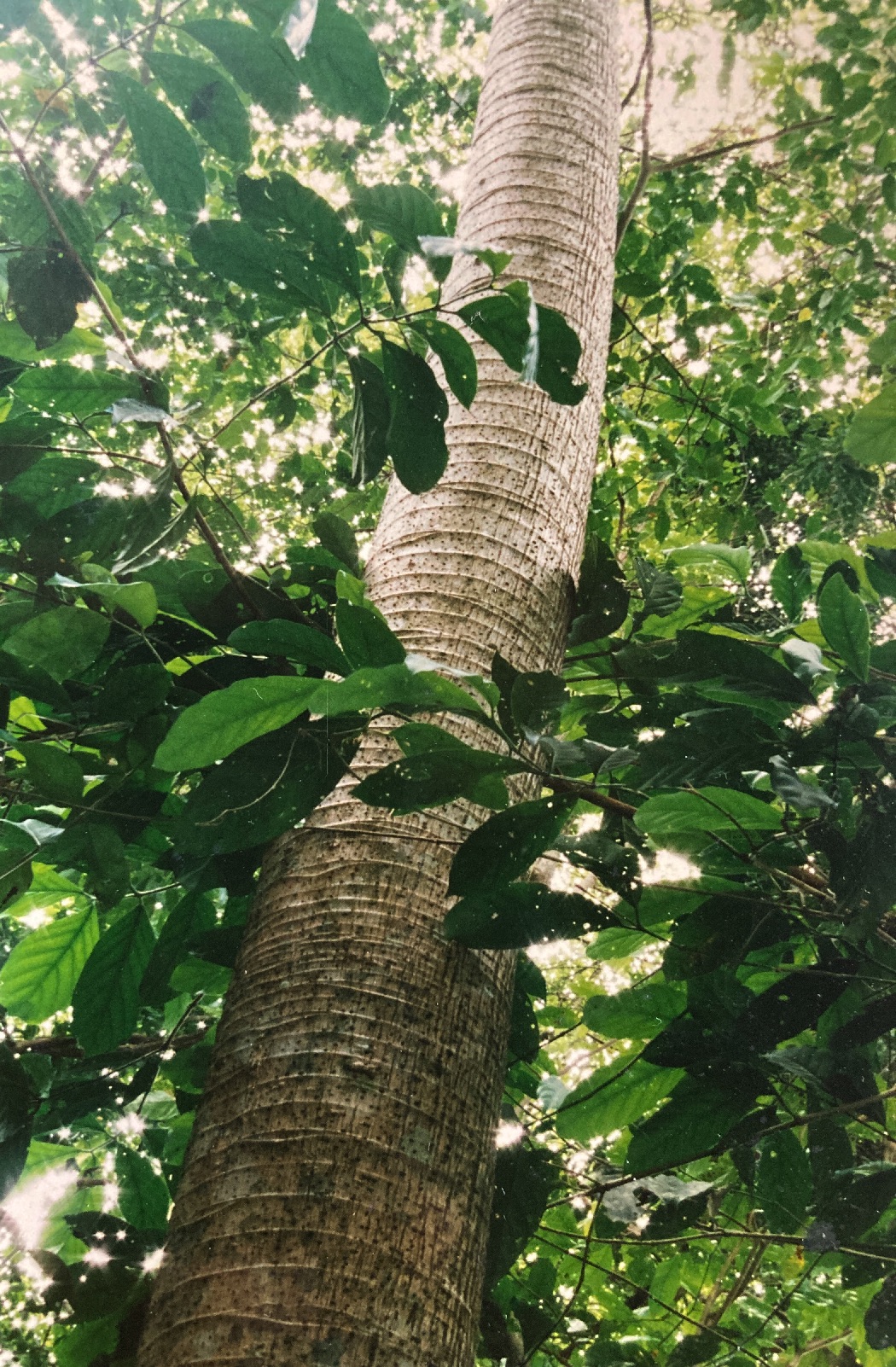Cecropia peltata L.
Cecropiaceae
CECROPIA, GUARUMO
Abundant evergreen tree (10-15 m) notable for its very large, deeply lobed leaves, hollow trunk ringed with leaf scars, and appeal to wildlife. Cecropia peltata is a pioneer species and is thus one of the first trees to appear in a disturbed habitat, growing rapidly and providing the ground cover necessary for the survival of less-hardy plant species.
Description: Cecropia seeds germinate most readily in soil that is warmed by a sudden influx of sunlight – perhaps caused by a treefall or some other disturbance that serves to break the otherwise continuous shade produced by an intact, primary forest canopy. A sun-loving species, Cecropia saplings proceed to grow rapidly and in the direction of the strongest source of light available. Trunks (25 cm) of mature trees are therefore invariably bending and curved as they wind there way up through the forest understory. Cylindrical, Cecropia boles bear many thin, elevated leaf scars that ring the trunk at more or less evenly spaced intervals. Generously dusted with dark, point lenticels, the thin bark is otherwise gray or creme colored. Usually, the trunk ceases to exist at a point just above the soil line, where it is transformed into a set of rapidly diverging roots that penetrate the substrate and provide support for the tree. Young Cecropia trees grow monopodially until reaching several meters in height. Even, the weak branches that appear in adolescent individuals die and rot away as the trees grow taller. As a consequence, the adult Cecropia shows no branching along the lower portion of its trunk. The few limbs that do remain are thin, long and wiry, often growing nearly horizontally and with leaves clustered around their tips. Cecropia crowns are thus extremely open, thin, and well lit – ideal for observing the wildlife that frequents them.
Leaves are simple, alternate and very large – with blades measuring 30 cm or more in diameter supported by long, 40 cm petioles. Each rounded, disk-shaped blade possesses nine palmately-arranged primary leaf veins and an equal number of conspicuous, finger-like lobes. Strongly curled about the primary veins, these lobes form deep troughs, giving the leaf a thick, wavy, three dimensional quality that helps to fill the otherwise Spartan crown. Leaf undersurfaces are markedly whitish and pale, starkly contrasting with their deep green upper surfaces. (When the advance winds of an approaching storm blow, Cecropia trees seem to communicate an air of urgency as their upturned leaves signal by flashing their startlingly white or silver sides – this effect is especially apparent and noticeable when the trees are viewed from a large distance). New foliage grows aggressively year round, slowing – but not stopping – only during the dry summer months. The fresh, expanding leaves of this species are often a striking red or orange color.
Cecropia trees are dioecious: their flowers are unisexual, and the male and female blossoms appear on different individuals. Minute and numerous, male flowers are borne on tassel-like panicles composed of about 10 or 15 thin, white, stringy strands attached to a stout pedestal. Measuring 10 cm in length, these panicles appear in the axils of new leaves and from underneath large, waxy, and maroon-colored protective sheaths. Female flowers are supported by similar panicles containing fewer (around six), thicker, rod-like strands. Fruits develop on the old, female inflorescences. The flower strands swell and thicken until they have become finger-sized or larger. Fleshy and soft, they are then composed of a fruity mass containing hundreds of minute (2 mm) brown seeds. Fruits and flowers are visible year round.
Similar Species: Only other species of Cecropia could be confused with C. peltata, since all members of this genus have similar foliage that is nonetheless unique in the plant kingdom. C. peltata is the only member of this closely knit genus represented in Manuel Antonio National Park (MANP).
Natural History: A pioneer species if ever there was one, Cecropia needs abundant sunlight in which to grow. Reportedly, seeds may remain in the cool, moist forest soil for many years, lying dormant until some calamity, natural or otherwise, allows a shaft of sunlight to reach the forest floor. The warmer temperatures thus generated stimulate germination and Cecropia seedlings become established in the light gap well before the seeds of most other species have even arrived. Through rapid growth, Cecropia trees maintain their lead over competing vegetation. The hollow bole – constructed of light, porous wood – reflects this strategy, for it allows the tree to reach significant heights without making the huge energy investment necessary to construct a massive and sturdy trunk. However, it also restricts the amount of weight the tree can support and ultimately severely limits longevity.
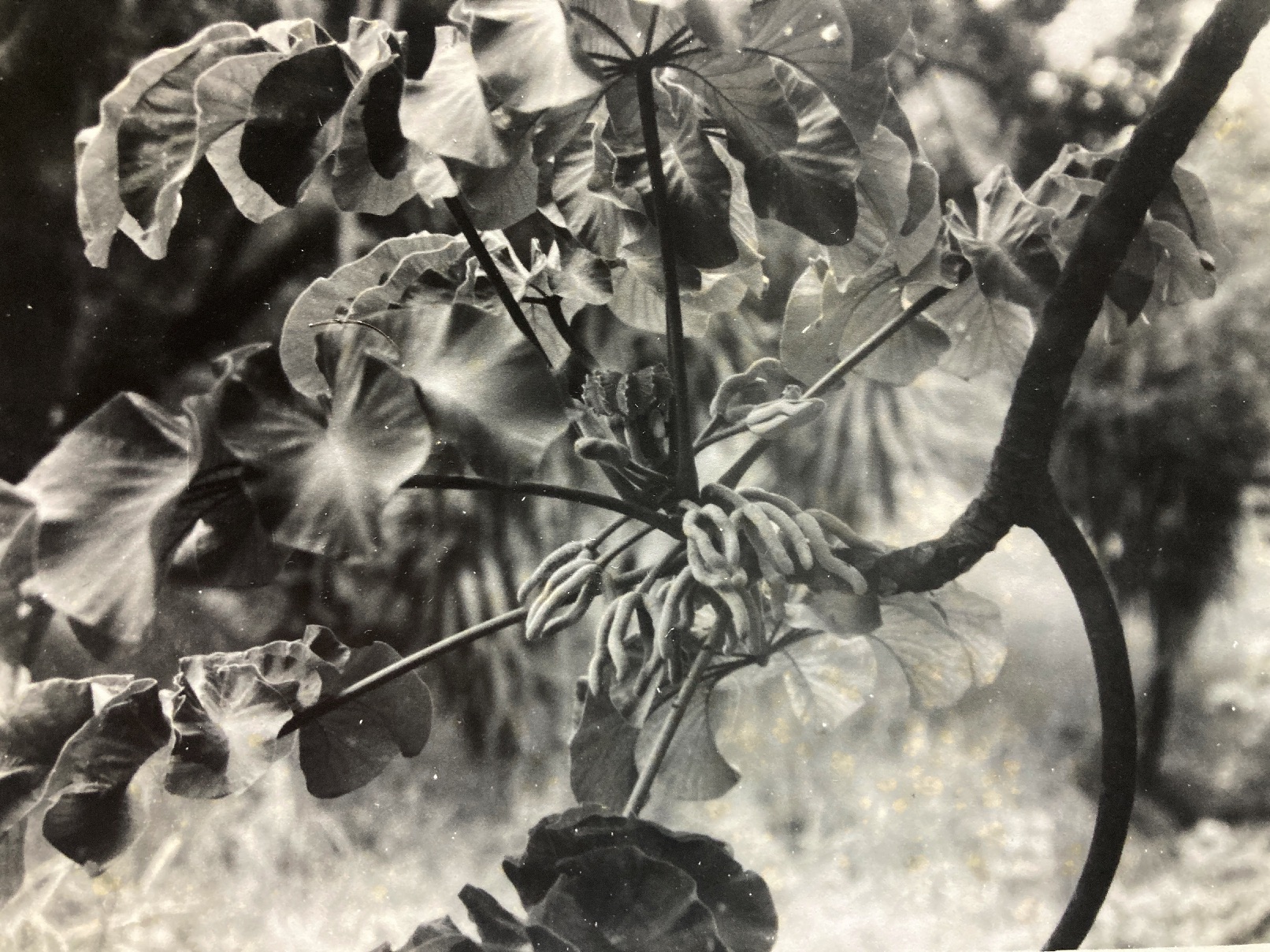
For most of their life span of about 20 years, Cecropia trees reproduce, scattering seeds – with the aid of dispersers – throughout the forest. Meanwhile, the shade they create helps to cool and stabilize the environment near the forest floor, enabling the seedlings of more sensitive but longer lived species to take root. Soon, the Cecropia trees die, disappearing from the scene and relinquishing their hold on the sunlight to the slow growing, arboreal vegetation beneath them. Meanwhile, dormant Cecropia seeds lie elsewhere, patiently waiting in the cool forest soil for the next emergent tree to fall.
Cecropia leaf scars provide an accurate record of every petiole a particular tree ever bore. By comparing the spacing between rings, one can get a sense for what growing conditions were like at different times during the tree’s life span. In places like Manuel Antonio, with a marked seasonal difference in the availability of moisture, trees grow slower during the excessively dry summer months. Such slowed growth translates into smaller spaces between leaves – and leaf rings – along the Cecropia trunk. (See image of trunk, above). As a result, older boles typically show repetitive, ring spacing patterns. Here, a series of closely spaced scars alternates with an even more numerous set of rings whose spacing is wide – corresponding to leaves produced during successive dry and wet seasons, respectively. Using this information, it is possible to determine the age of Cecropia trees and even to compare the severity of different dry seasons.
Cecropia trees are inhabited by a species of Aztec ant. These insects, finding shelter within the hollow bole of the tree, pay for their lodging by providing protection from potentially damaging plant and insect parasites. This type of close interrelationship between two species, formally known as symbiosis, is further said to be mutualistic, since both organisms benefit from the association.
Finally, a wide range of animals can be observed foraging within the cage of spindly branches that make up the Cecropia crown. Perhaps most famously, two and three-toed sloths feed on this tree’s flowers and fruits, and they are frequently seen among its branches, either resting and immobile or slowly moving from limb to limb. It is sometimes thought that sloths prefer Cecropias to other forest trees, because they are seen in them so often. However it is likely that these frequent sightings are a reflection of the relative ease with which sloths can be spotted in the open Cecropia crown. Sloths in other forest trees, whose thick crowns obscure visibility, generally go unnoticed. Birds, too, can be seen on Cecropia branches, looking for fruits and insects – or just in need of an open perch to peer from. Euphonias, Laughing Falcons, and Trogons are some of the species commonly observed in this way.
As a side note, many experienced hikers have been momentarily fooled – and even startled – by two pieces of discarded Cecropia anatomy. First, the dead, curled leaves scattered on the ground and seen at a glance can resemble coiled snakes. The deadly nature of certain venomous, Costa Rican species (particularly the Fer de Lance), make this an unpleasant – if momentary – perception. Second, the core of the hollow Cecropia trunk is lined by a translucent, plastic-like material that is divided into hollow cells. When the wood of the tree decays away, these chambers remain behind – lying on the forest floor and strongly resembling the vertebral bones of some unfortunate animal.
Uses: The Cecropia is an ideal species to use in the initial stages of a land reclamation or reforestation program. Hardy, these trees can grow in poor, eroded soils while still withstanding the full brunt of the tropical sun. (In Manuel Antonio, Cecropia trees actively colonizing a formerly primary forest region after a devastating storm have been observed to reach 22 cm in diameter and 13 m in height less than 3.5 years after germination). In time, they will help to provide the shade and organic material necessary to allow other, less rugged species to survive. Cecropia trees also benefit the local ecology, for they perpetually produce flowers and fruits that are staple foodstuffs to many bird and mammal species.
The soft, resilient wood of Cecropia roots resists splitting – and it has been used to make tool handles.
Distribution: In MANP, Cecropia can be found in any secondary forest, along road and trail sides, and in light gaps inside the primary forest. It ranges from Mexico and the Antilles to Panama and northern South America.
Images: Tree Tree2 Tree3 Trunk Leaf Flower (Male) Flower (Female) Fruit Fruit&Seed

